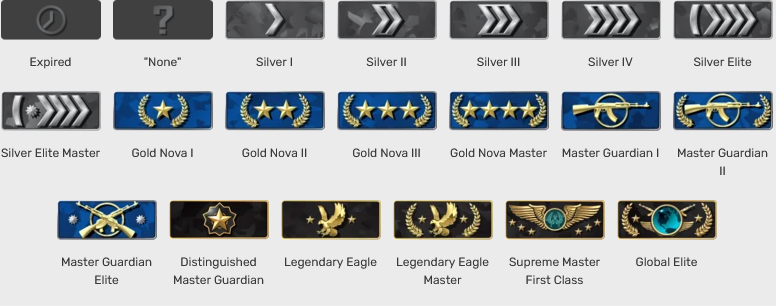Understanding the CS:GO ranked matchmaking system
Climbing the Counter-Strike: Global Offensive matchmaking ladder is no simple task. Our guide explains everything you need to know if you’re new to the matchmaking system or want to climb the ranks!
Climbing the Counter-Strike: Global Offensive matchmaking ladder is no simple task. Our guide explains everything you need to know if you’re new to the matchmaking system or want to climb the ranks!
Counter-Strike: Global Offensive has a convenient in-game matchmaking system available to all players. First introduced in 2012, CS:GO’s ranked matchmaking system offers players the opportunity to compete for a skill rank.
Compared to the casual game modes, ranked matchmaking is taken more seriously. Furthermore, you’ll find that your teammates expect a particular level of teamwork and skill, especially at higher ranks.
It’s no secret that CS:GO’s ranking system can be hard to navigate. No one knows all the details, and Valve isn’t known for sharing all its secrets. However, our guide will teach you everything you need to know about the different ranks and matchmaking systems.
There are two types of matchmaking types in CS:GO: ranked and unranked. In the first type, players are matched into a lobby based on their skill group. Moreover, a player’s skill group (rank) can be seen. When playing with friends, ranked matchmaking is far more restrictive. To keep matches fair and competitive, Valve only allows players to queue with others within five ranks of their skill group. That means a player can play with someone five ranks higher or lower than themself. An exception to this rule is when five players queue together. Players of any rank can play together as long as they are queueing in a full group of five. Also, ranked game modes are only available to players that have Prime status.
On the other hand, in unranked a player’s skill is based on their performance. However, their skill group is not public. Furthermore, there aren’t restrictions on skill groups for players that are grouping together. Players who do not have Prime status are able to play unranked with no issues.
Each game mode has a ranked and unranked option. Therefore, Competitive, Wingman and Danger Zone have ranked skill groups. Below are the skill groups for each ranked game mode. The skill groups increase from left to right.



To get an accurate CS:GO rank, the game’s matchmaking system has to collect some performance data over several games. Players new to ranked need to win 10 competitive placement matches. This doesn’t mean that you have to simply play 10 matches, but that you need to win 10 matches.
When starting out, you will not be able to win more than two ranked matches per day. Also, you will not be able to join a competitive queue with someone who is ranked Master Guardian II or higher, unless you are in a full group of five.
Once you’ve won your first 10 ranked games, you will be assigned a rank between Silver I and Legendary Eagle Master. After being placed in your skill group, you are free to win more than two games per day.
At first, your skill group might not reflect your skill. Perhaps the system placed you a bit higher than your skill level or maybe lower. As you continue playing though, you’ll eventually win or lose enough games to settle your appropriate rank.
There’s no way for players to know how many games they have to win or lose to move up or down into a lower skill group. However, there are two game modes Wingman (Operation Hydra Only) and Weapons Experts (Operation Hydra Only) in which players are able to see how many matches they need to win to rank up.
You will be removed from your skill group if you don’t play any ranked matches for one month. To be placed into a skill group again, you’ll have to tie or win a ranked game. If you’ve been inactive for longer than a month, you’ll more than likely be placed into a lower skill group. However, it’s not uncommon for players to place in the same skill group they were in before their rank expired.
Unfortunately, Valve has not been the most public in regard to how exactly a player's performance, win streaks, or other factors affect their rank. Initially, to rank up it’s pretty simple- win! However, as you continue to play, you’ll eventually notice it’s extremely difficult to rank up.
Players have reported winning several games in a row without ranking up, and then losing two to find themselves in a lower skill group. This phenomenon has driven the community to decipher CS:GO’s inconsistent and somewhat volatile matchmaking system.
Several years ago, a Valve Employee gave players insight into how ranks are determined in the backend. They explained CS:GO’s ranked matchmaking skill groups are based on the Glicko-2 rating model. The employee clarified a player’s skill group is determined by “multiple matchmaking parameters,” and that their “complex competitive matchmaking parameters cannot be represented as a single numeric value.”
Since we know that CS:GO’s skill groups are based on the Glicko-2 rating system there are a few things to keep in mind if you’re trying to rank up.
Now that you know the most important aspects of the CS:GO ranking matchmaking system, head out and win some games! Send over any comments or feedback to Twitter! Stay tuned to Dignitas for more Counter-Strike Global Offensive guides!